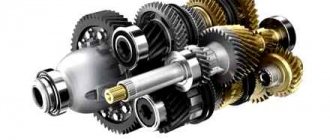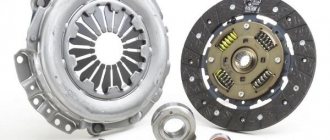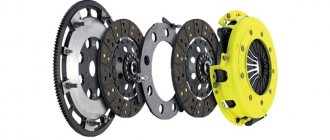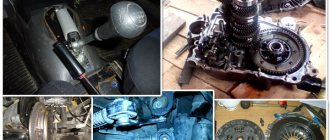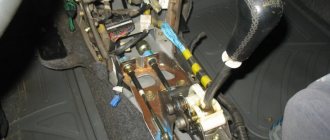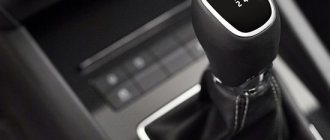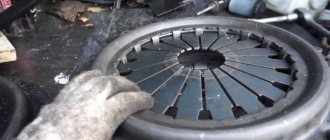When the speed of the car begins to turn on heavily, it not only causes an unpleasant feeling, but also makes the operation of the car unsafe. In this article we will look at the points why is it hard to shift gears, or do not switch at all, which is usually associated with this.
The gearbox is a complex mechanism that requires constant maintenance. Including regular diagnostics and gearbox oil changes. Ignoring these measures often leads to problems with gear shifting.
For what reasons do interruptions occur?
The gearbox is not only one of the most complex, but also one of the most basic components in any vehicle. The reasons for malfunctions that make it difficult to engage first gear can be associated with both incorrect use of the unit and driving on a bad road surface. In any case, if you don’t know why the speed turns on poorly, then this indicates a certain breakdown of the unit itself.
Gear lever
It should be noted that a similar problem often occurs in older cars that are bought second-hand and not at car dealerships. Therefore, if you purchased a used car, then you shouldn’t even be surprised by such a problem, especially since similar faults will appear in any car sooner or later. In addition, if you try to turn on the speed and this happens, but very poorly and with great difficulty, then over time the unit selector may completely stop responding to any commands from the motorist. Naturally, not every driver will be able to constantly start driving in second gear, so it is important to understand the reasons why first gear is difficult to engage.
Below is a list of breakdowns that can cause the gear lever to shift gears poorly:
- The problem is in the clutch operation - the mechanism engages poorly, disengagement is incomplete. This problem often occurs in domestically produced cars and in most cases it is due to the fact that the mechanical clutch cable comes off from the mounting point. In fact, it is not particularly difficult to identify this - if the cable breaks, the pedal will be recessed into the floor and will not move. This, as you understand, is directly related to the operation of the clutch, and not the gearbox.
- There was a breakdown in the operation of the drive rod for controlling the gear shift mechanism. Then not only the first, but also the reverse and other speeds will turn on poorly.
- Failure of the unit's jet thrust.
- For unknown reasons, the fastening bolts located on the side or selector rod for selecting the gearbox mode have become loose. The problem is solved by tightening the bolts.
- The transmission gear shift drive was incorrectly adjusted.
- The plastic elements in the gearbox control drive have failed or have expired.
- The link was poorly adjusted. As you know, the purpose of the rocker is very important in connecting the gearbox and the gear selector, so incorrect adjustment may well be the cause of the problem. In addition, the plastic bushings on this link could wear out or fail.
- Failure of synchronizers can also be called one of the most common failures in a gearbox. Unit synchronizers are brass bushings necessary for easier switching of unit modes. Since brass itself is a soft material, it can wear out and wear out during the operation of the vehicle. To correctly diagnose the condition of the synchronizers, you should pay attention to the operation of the gearbox - if a grinding or unpleasant sound appears when shifting gears, then the problem is in them. Moreover, this sound will appear constantly when you try to engage first gear. If only sound appears, but the gearbox selector switches to one mode or another without problems, then a malfunction will occur soon.
- Failure of gearbox bearings. Such a malfunction does not occur so often, one might even say that it is rare, but any motorist can still encounter it. If you own a car with a manual transmission, then the bearings could get stuck in it, as a result of which the shaft stops rotating along the path. In such cases, it is difficult to engage first gear; at other speeds the problem usually does not appear.
- The box shaft has failed. The unit shaft is usually not subject to operational wear or very heavy loads, but the malfunction may be caused by a factory defect. In the event that even minor mistakes were made in production, the shaft may well break. If so, then the problem of engaging the first gear may be just the beginning of a major breakdown that you will face. As practice shows, often in such cases the unit itself breaks down completely.
- The problem of clutch failure is relevant for owners of cars with automatic transmission. There are cases when, if the clutches are not functioning correctly, a push occurs when the first speed is turned on, but then everything works fine. The problem can only be solved by replacing the clutches.
Failed bearing
You, as a motorist, need to understand that failure of the unit shaft or bearings cannot be diagnosed at home. Only experience and equipment will help you understand this reason. Accordingly, if problems arise with turning on the first speed, it is advisable to immediately contact a professional.
Gears engage with effort: gearbox malfunctions
In cars with a manual transmission, gear shifting is done by the driver himself. Using a lever from the interior, it acts on the rocker and then on the entire gearbox mechanism. Simply put, the driver moves the gears on the shafts.
Since the shafts rotate at high speeds, cooling is required. This is done using special gear oil. Oil also protects the surfaces of rubbing parts from premature wear. The lubricant must be changed on time. On average, this is done after every 40-50 thousand kilometers.
As for the reasons for tight gear engagement, there may be several of them. However, most often they are associated with problems in the clutch or the gearbox itself. If you study the list of the most common breakdowns, then you can highlight the following:
- the link is poorly adjusted. In particularly difficult cases, it may be necessary to replace the plastic bushings. This procedure, like adjustment, can be done on your own;
- hydraulic drive failure. If it leaks, you may not be able to engage the gear at all, since it is impossible to disengage the clutch;
- the clutch cable has broken or fallen off (in a cable clutch);
- The clutch basket has failed.
The exception is reverse gear, since it does not have synchronizers; By the way, when the reverse gear is difficult to engage, extraneous noises, clanging, and crunching often occur. Such phenomena directly indicate wear of the gear teeth.
How to engage first gear without harming the gearbox?
Often, inexperienced motorists, turning the gearbox selector from second to first speed, may notice how some difficulties arise, in particular, how difficult it is to engage first gear. In such cases, a novice driver often tries to turn on the speed using force, simply by driving the selector into the desired position. This should not be done under any circumstances, since such actions can be fraught.
Actually, having noticed such a drawback in the manual transmission, motorists developed a rule - the first speed should be engaged only in order to move away. In all other cases, second, third and fourth gears are engaged. Experienced motorists especially often use this rule, but we would like to say on our own that this is fundamentally wrong.
Operating principle of gearbox synchronizers
Any driving instructor will tell you that the choice of speed should be based on driving speed and engine crankshaft speed. In principle, even parking normally is only possible in first speed. If you try to park in second gear, you will have to maneuver very quickly, and in such cases there will be a strong load on the clutch. Actually, just like the gearbox unit itself. Accordingly, you must learn one simple rule for yourself - you can engage first gear when driving only if the speed is low and the crankshaft speed is low.
Why is it difficult to engage manual transmission gears?
manual gear shifting
- The most common problem is clutch failure. In such a situation, reverse gear turns on with a bang. This happens because the gear overlaps the tooth. Reverse speed is the only gear in the box that does not have synchronizers. For this reason, clutch failure is so obvious on it.
- The second reason is a defect in the mechanism responsible for selecting the gear. This breakdown occurs when the car is stationary and you try to shift into gear.
- The third is severe wear of the gearbox synchronizers. Mostly, breakdowns occur with those that are most often used. These are first, second and third gear. Severe wear of the synchronizers only appears when switching while driving.
To prevent possible gearbox malfunctions, perform regular maintenance, change the oil on time, and in case of minor failures, rush for diagnostics . This will save you time and money in the future.
Watch the video for what not to do with a manual transmission:
What to do if it is difficult to engage reverse gear?
If you have difficulty engaging reverse gear, do one of the following :
- When you feel that the gear has not reached the end, release the clutch slightly, and the gear will be inserted all the way.
- Fully depress the clutch and only after a few seconds engage reverse gear.
- Depress the clutch, set the gear to neutral and release the clutch. After this, press down and engage reverse gear.
- Shift into reverse through another gear. For example, first engage 4th and then shift to reverse.
Theory of gearbox operation
Every motorist who understands the structure of a gearbox knows that all modern cars with a manual transmission are equipped with synchronizers. This element is one of the important components of the unit. The purpose of synchronizers is to equalize the speed of all gearbox shafts. In addition, these elements are responsible for painless and shock-free gear shifting for the box.
It should be noted that directly when the driver pushes the gearbox selector when switching from second to first gear, you can feel an obstacle. This obstacle prevents the activation of the first speed and it is this obstacle that is called the synchronizer. If the gearbox is relatively new or a synchronizer has recently been installed on it, then you will not experience problems with the transition from high speed to low speed. The first gear will be engaged without any obstacles.
Worn out synchronizer
But if your vehicle has already traveled more than a hundred thousand kilometers, then this will directly affect the functioning of some elements of the unit. In particular, first of all, synchronizers will stop working normally - they simply will not be able to perform the tasks assigned to them initially. Then the motorist is forced to perform various “tricks” that our grandfathers told us about - these are all kinds of gas shifts with double disengagement of the clutch and so on.
When performing such tricks, the throttle change will act as an equalizer for the interconnected gears. Thus, if the difference in angular speeds is high, and the synchronizers are worn out quite badly, then the driver will have to accelerate even more. In the case when the angular speeds are the same, the motorist will immediately understand this - the gearbox selector will be able to switch from high speed to low speed without any problems. Thus, it will no longer be worthwhile to make efforts.
New synchronizer for gearbox
Methods for engaging first gear
So, if the modes in your vehicle are difficult to engage and you have already understood the reasons and theory, then let’s move on to the most important thing - methods for engaging first gear. The simplest method in this case would be to activate first gear while driving the car. You need to push the unit selector forward without any effort and do this until the corresponding synchronizer comes into operation. However, it should be noted that this method is relevant for most passenger vehicles and some trucks.
It should be taken into account that this cannot be done in most old trucks, since the design of the unit itself does not allow this, since they simply do not have synchronizers. In addition, you need to take into account that this method of activating the first speed is hardly relevant if the synchronizer on your vehicle has already exhausted its service life. This will simply be impossible.
Double car re-gas
Then the driver will only have to wait a while until the car practically stops in order to turn on the desired speed. Or use force to engage the gearshift lever. In principle, neither the first nor the second method can be called the optimal solution to such a problem. As practice shows, it is best to use the same old-fashioned method with re-gasping.
You can find out how to do this below:
- So, while driving in second gear, start depressing the clutch pedal.
- When you press the pedal, move the gearbox selector to the neutral position. Having done this, you can disable the clutch pedal.
- Then, when the pedal is completely lowered, you need to lightly press the gas with your right foot, pressing the pedal. In this case, pay attention to the tachometer, which shows the number of revolutions. You need to increase the revolutions to two and a half thousand per minute, that is, the needle should be at the number 2,500. Here, pay attention to one important nuance - the greater the difference in angular speeds of the mating gears of the box, the higher the number of revolutions needs to be raised. That is, 2,500 is the minimum, add gas if necessary.
- Then depress the clutch pedal again.
- Next, the box selector should be moved to the initial mode activation position, that is, first speed. Here, also pay attention to the fact that if the selector does not enter the required position correctly, then most likely you simply did not give enough gas. If this is the case, then repeat the steps, only add more gas.
- As a result, you need to release the clutch pedal smoothly, not abruptly. If you did everything correctly, the gearbox lever will move to the required position without any problems, shocks or extraneous sounds.
If you were unable to do this, then do not be discouraged - rarely does anyone manage to perform a double gas change the first time. By repeating the procedure several times, you will be able to remember everything that needs to be done to correctly engage the first speed. Actually, the same methods allow you to activate first gear when driving in third, for example, if in an emergency you need to brake the engine. In this case, the higher the driving speed, the longer you will need to wait for the synchronizers to help you. Or you need to press on the gas more.
But do not regard double throttling as a way out of the situation. This method can be called a temporary solution, but the unit will still have to be repaired. Since replacing synchronizers is a rather complex process, we recommend that you seek help from specialists. If you still decide to perform this procedure yourself, then the instructions provided below will be useful to you.
Changing synchronizers
Replacing gearbox elements is carried out in several stages. We will not describe them in detail, since all actions are individual for each individual car.
Moreover, if you have never encountered such a procedure, you are unlikely to be able to perform it yourself:
- First you need to remove the gearbox from its installation location. To do this, use the recommendations in the service manual or search our resource - here you can find several instructions. The dismantled gearbox is thoroughly cleaned of dirt and dust.
- After this, you should remove the clutch cable retainer.
- Next, unscrew the four nuts that secure the rear cover of the unit; move it to the side.
- After this, unscrew the screw securing the fifth speed fork. Then turn it on, to do this you need to move the synchronizer clutch down with the fork. This must be done in such a way that the coupling splines are together with the gear. Having done this, you should activate either the third or fourth speed.
- Then you need to unscrew the nut that secures the input shaft. To be able to move it out of place, pull the key firmly, since it is most likely tightened with force. Carry out similar actions with the nut that secures the secondary shaft.
- Next, lift the fifth speed gear and remove it with the synchronizer and the secondary shaft fork. Please note: the clutch should not move from the hub at this point. Installation of new elements is carried out in the reverse order. You need to be as careful as possible. As you can see, in general the process is quite complex and responsible, so do not bother replacing synchronizers without experience.
If you have a mechanic
Gears shift poorly in a car with a manual transmission for three reasons. The first of these is a malfunction of the clutch when it does not completely disengage (drive). The first sign of this malfunction is that the reverse gear is engaged with a characteristic crash. The rear one reacts to this anomaly more noticeably than other gears, because it is the only one not equipped with a synchronizer.
The second reason is a defect in the gear selection mechanism of the gearbox. And finally, the third is excessive wear of the gearbox synchronizers.
There are also several clutch malfunctions in which manual transmission gears shift poorly:
- Air in the clutch release hydraulic drive or fluid leakage from it. The malfunction is eliminated by replacing failed components of the hydraulic system and pumping it.
- Worn or broken clutch release fork. The part requires replacement or repair.
- Warping (runout greater than 0.5 mm) or too thick new driven disk.
- Failure of the basket (temperature deformation of the pressure plate or its distortion).
- Loss of mobility of the support bearing of the gearbox input shaft (at the end of the crankshaft to which the flywheel is attached).
- Jamming of the clutch driven disc hub on the splines of the gearbox input shaft. To eliminate the defect, clean the splines of the gearbox hub and input shaft. It wouldn’t hurt to lubricate them a little with lithol.
There is too much free play in the clutch release fork. Its value needs to be clarified with the manufacturer, since it is slightly different for different cars. Until you find out the value of this parameter for your car, set it from 5 to 8 mm. Too little free play of the fork is also undesirable, as it leads to clutch slipping and increased wear of the release bearing.
Excessive wear of synchronizers mainly occurs in those gears that are engaged more often: these are usually first, second and third. The rear one is not included in this list because it does not have a synchronizer. When your gear shifts poorly, and you assume that the reason for this is wear of the synchronizers, firstly, you should only have difficulties with this while driving. Secondly, in this case it switches better if you use double squeeze.
For those who don’t know what double squeeze is. To shift to a higher gear: depress the clutch, engage neutral, release and depress the clutch again, engage the gear.
Backlash in the so-called “helicopter” is one of the reasons for unclear gear shifting
To switch to a lower gear: double squeezing must be combined with re-engaging, that is, when the clutch pedal is released and the gearbox is in neutral, you need to press and release the accelerator pedal. This is how gears are changed in cars that do not have synchronizers. If the gearbox shifts easier using double squeezing, then the culprit for poor gear shifting is most likely worn synchronizers.
If the gears shift poorly when the car is standing still with the engine turned off, the fault may only be in the gear selection mechanism of the gearbox.
Look for damage or check that it is adjusted correctly. Don't even think about the clutch and synchronizers.
Common causes of problems with first gear on popular cars
Some car models, due to their design features, are more susceptible than others to problems with engaging first gear. In order not to cause a problem and avoid serious damage, they need to monitor potentially vulnerable components and have them serviced in a timely manner. Such cars are collected in the table below.
| Brand, model | Design flaws, weak points | How to prevent the problem |
| VAZ 2108-2115 | The gearbox supports (side and rear) often wear out, causing gears to fly out. Due to the large difference in gear ratios of 1st and 2nd gears, their synchronizers wear out more. Difficulty engaging first at speed is not yet a breakdown, but a characteristic drawback of VAZ front-wheel drive gearboxes, caused by an almost 2-fold difference in the gear ratios of 1st and 2nd gears. But it can develop into problems if you regularly engage the gear with force. A loose cardan of the rocker leads to unclear movement of the lever. |
|
| VAZ 2110-2112, Priora, Kalina | On a car with a rocker drive, the problems are the same as for Samara (weak synchronizers, wear of the cushions, the rocker). Added to these are problems with the gearbox torque rod, damage to which deprives the box and the rocker of a rigid connection. On a car with a cable-driven gearbox, there may be a problem with their tension. | |
| VAZ Classic (06,07,01) | Due to a fluid leak or incorrect stroke adjustment, the hydraulic shift drive does not completely disconnect the engine from the gearbox when the clutch is depressed. | Check the fluid level in the clutch circuit and the adjustment of the release mechanism, add brake fluid and bleed the clutch if necessary. |
| Lada Vesta | On modifications with a VAZ gearbox, the problems are the same as on earlier models: load on the 1st and 2nd synchronizers, unstable gear shift drive. | Gently shift into 1st and 2nd gears, use high-quality gear oil. |
| Volkswagen Passat (from b3 to b8) | The Volkswagen Passat uses a cable shift mechanism, which is sensitive to wear and requires maintenance. | Periodically (at least once every 10 thousand km) inspect the gear selection mechanism and its movement. Adjust cables and replace worn parts. |
| Chevrolet Aveo T250, Lacetti, Daewoo Lanos, Sens, Nexia | On the Chevrolet Aveo and a number of other models developed by GM, the weak point is the shift mechanism (“helicopter”) at the gearbox, which becomes loose. Because of this, it becomes difficult to catch the desired speed. | Monitor the “helicopter”, clean it periodically, and if noticeable play appears, change the switch parts. |
| Hyundai Solaris | The weak point is the clutch circuit. If there is a lack of fluid or air, the clutch is not fully depressed, which is why the first one is difficult to engage. The adjustment of the rocker cables may also go wrong. | Check the fluid level in the clutch circuit and the tension of the gear shift cables. Adjust the clutch drive and cables if necessary. |
| Mitsubishi Pajero | The selector switch on the automatic transmission (inhibitor) often turns sour. | Avoid heavy contamination of the gearbox, monitor its condition and clean it if it is heavily soiled. |
| Gazelle | On the Gazelle, first gear is difficult to engage due to wear on the clutch or problems with its drive. | Periodically (at least once every 10 thousand km) inspect the clutch drive for leaks. If necessary, adjust the drive and bleed it. |
| Opel Astra G (including automatic transmission and robot with 1 clutch) | The weak points on the mechanics are the lever linkage (there are plastic parts there), the “fingers” and the “helicopter” of the gear selection mechanism at the gearbox. Sometimes its settings simply go wrong and production appears. | Monitor the adjustment of the switching mechanism, adjust it in a timely manner or repair it if unclear movement or play appears. |
| Automatic transmission is sensitive to oil level and quality. | Monitor the oil level and change it regularly every 40–50 thousand km. |
For those with automatic
If your car has an automatic transmission. It will not hurt you to know the modes in which your machine can operate:
- P – For parking and starting the engine. Switching to this mode is possible only after the machine has completely stopped.
- R – To move backwards. Switching to this mode is also possible only after stopping the car and with the brake pedal pressed.
- N – Neutral. When the engine is completely disconnected from the gearbox.
- D – Moving forward without restrictions on gear shifting (the most commonly used operating mode of the automatic transmission).
- D3(S) – Low gears for climbing and braking engines on descents.
- D2 – Mode for difficult conditions (slippery or mountainous roads). Gears above second are not shifted, that is, only first and second gears are engaged.
- D1(L) - Movement occurs only in 1st gear, used off-road on mud, snow or ice, where you need to drive without changing the throttle, and also to overcome steep climbs.
The automatic transmission also has a button on the mode shift lever with the inscription O/D OFF. When it is turned on, the inclusion is prohibited, increasing the gears of the analogue of the 5th gear of the manual transmission. That is, if your automatic machine has 4 gears for moving forward, then for more dynamic acceleration it will use only three lower gears.
About a faulty automatic transmission, an automatic transmission is much more complex than those encountered with a manual transmission, and the chances of repairing it in your garage are slim. But despite this, you still need to know something about it, if only in order not to harm it through improper use.
An automatic transmission is much more demanding in terms of accuracy in maintaining the oil level in it than a manual transmission. Both too low and too high oil levels are very harmful to her. Both of these can lead to serious damage. In both cases, oil foaming occurs. When there is a lack of oil due to the fact that the oil pump begins to capture air along with the oil. When there is excess oil, it foams on the rotating parts, which in this case are immersed in it. Foamed oil compresses better and has low thermal conductivity. Therefore, if you operate a machine with such oil, the pressure in its control systems will be low. Which will lead to slipping of the clutches and their intensive wear. Deteriorated thermal conductivity will not allow all excess heat to be removed. Which, together with low pressure, will lead to the machine failing and requiring serious repairs.

